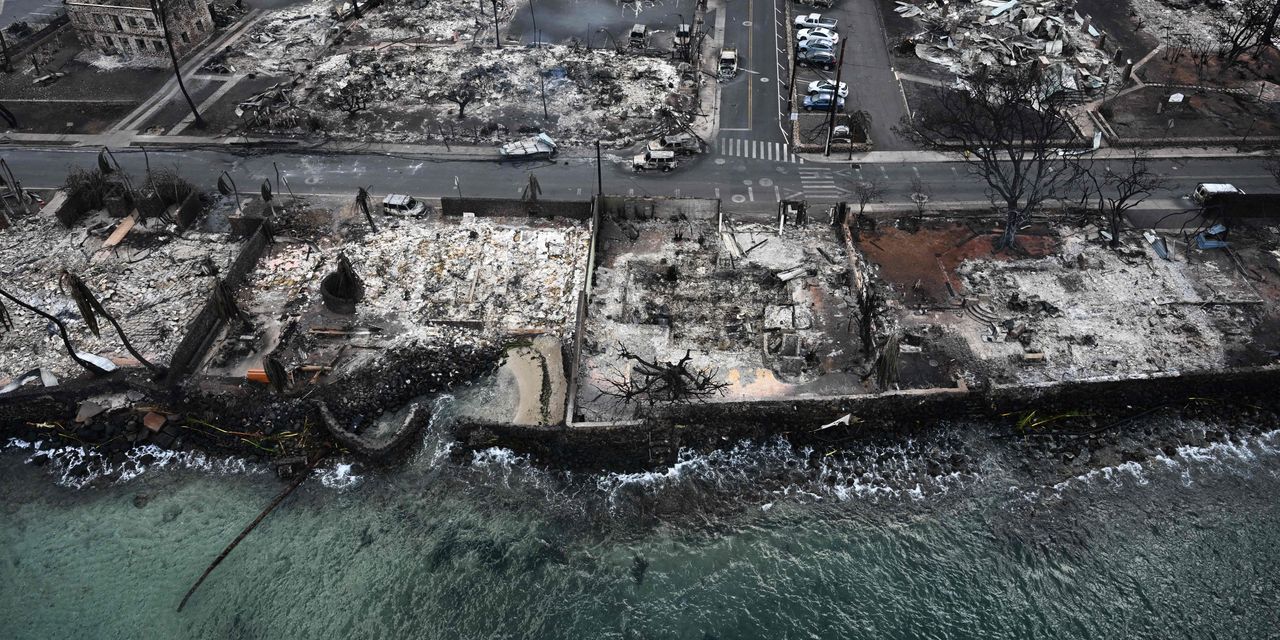Shares of
Hawaiian Electric Industries
plunged as much as 41% on Monday amid accusations that downed power lines may have caused the wildfire that destroyed the town of Lahaina, Hawaii, and killed at least 93. The stock closed down 34% for the day.
Hawaii’s state attorney general has announced an investigation into the cause of the devastating fires on the island of Maui. While no official cause has been determined, some are accusing Hawaiian Electric (ticker: HE), the state’s largest power provider, of failing to implement safety measures.
Hawaiian Electric didn’t respond to Barron’s request for comment, but has told Bloomberg that it doesn’t have information on what caused the fires.
A lawsuit seeking class-action status was filed over the weekend against the utility. The suit alleges that strong winds had downed some of Hawaiian Electric’s electric power lines, but the company didn’t turn off power despite warnings of high fire danger conditions from the National Weather Service.
The fire spread quickly thanks to an unusually dry summer in Hawaii this year and strong winds from a passing hurricane. Many residents didn’t have time to evacuate.
How Damaging Was the Fire?
Lahaina, a historic town and economic hub of Maui, was reduced to ash within hours. The official death toll of 93 is likely to rise in the coming days, officials say.
Over 2,170 acres of land have burned in the Lahaina fire, leaving around 2,200 structures damaged or destroyed, according to initial assessment from the Pacific Disaster Center and FEMA on Saturday. Eighty-six percent of buildings exposed to the fire were residential, according to the report.
Hawaii Gov. Josh Green said on Saturday that the losses could approach $6 billion. In a Saturday statement, FEMA says it is still too early to determine the cost of rebuilding.
If Hawaiian Electric is found at fault for starting the fire, it could lead to billions of dollars in liabilities, according to financial analysts. Much of the utility’s own equipment has also been severely damaged, leading to a large-scale power outage on Maui.
Although the utility’s insurance policies could provide some protection, they might not fully cover the costs if the utility is found liable. Hawaiian Electric hasn’t disclosed the deductibles or limits of its insurance, but
Wells Fargo
analysts estimate that the coverage is likely under $1 billion.
Most of the firm’s overhead and underground electricity transmission and distribution systems are uninsured, except for those located within 1,000 feet of its generating facility or substation, according to Evercore ISI analyst Michael Lonegan.
Hawaiian Electric might face especially severe financial challenges due to its relatively small size if found liable for the fires. “The problem is that the costs are escalating to the point they’re substantially higher than what the company is even worth,” says Shahriar Pourreza, a utility analyst at Guggenheim.
Hawaiian Electric’s market cap has shrunk to just $2.4 billion following the latest plunge in its share prices. Apart from its potential legal exposure, the company could face liquidity issues as it tries to continue operating the business while recovering from fire damages, analysts said.
“Who’s going to lend to them right now?” says Pourreza, “Everyone’s gonna watch very closely to see if they start to draw credit lines to drum up liquidity and what they do to the dividend.”
How Is Hawaiian Electric’s Trouble Similar to PG&E?
The plunge in Hawaiian Electric’s stock price is similar to what happened to Pacific Gas and Electric after the 2018 Camp Fire, which destroyed the town of Paradise and killed 85 peop; le in Northern California.
PG&E,
the utility company serving the region, was found liable for the fire due to equipment malfunctions and inadequate maintenance. This has led to a wave of lawsuits and financial liabilities that mounted to more than $30 billion.
The financial pressure forced PG&E to file for Chapter 11 bankruptcy protection in 2019, which allowed the firm to reorganize its debts and obligations while continuing to operate its services. PG&E stock plunged since the Camp Fire and never recovered. The shares have lost 60% of their value from five years ago.
What Is Different This Time?
California has a stricter liability rule called “inverse condemnation,” which entitles property owners to fair financial compensation if their property is damaged by public use from governments or public entities. In case of wildfires, it means utility firms are assumed guilty first until they are proven innocent, says Pourreza.
Hawaii doesn’t have such rules, which means the plaintiffs would have to prove that utility firms have operated the system improperly and failed to take reasonable steps to prevent the damage from happening. “Hawaii has a looser standard than California does, which makes it a little bit easier [for Hawaiian Electric to defend against the accusations],” Pourreza told Barron’s.
The company told Evercore’s Lonegan that it has records of equipment maintenance and vegetation management, but has nothing to share at the moment as it’s focusing on supporting first responders, helping its customers and employees, and restoring power as soon as possible.
What It Means for Investors
Pourreza expects the firm’s valuation to shrink by $2 billion from its value before the fire and has cut his price target to $18 from $32. The stock will likely remain under pressure during investigations and response, he wrote: “We anticipate a long road until investors can gain clarity from the incident and resulting claims.”
Looking forward, the current company structure might change materially, he says, including partial asset buyouts or government intervention. “Given the size of the utility and the potential liabilities in front of it, it’s hard for us to imagine if the company will emerge from this tragic incident in its current form.”
Wells Fargo has also lowered it’s price target for the stock to $25 from $35. Shares are trading at $21.46 by Monday’s close.
Write to Evie Liu at [email protected]
Read the full article here



